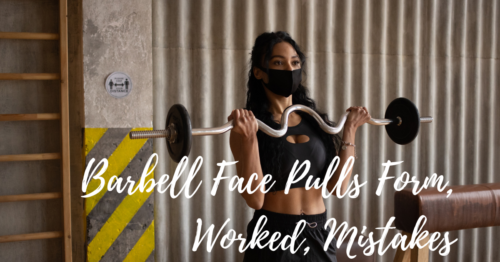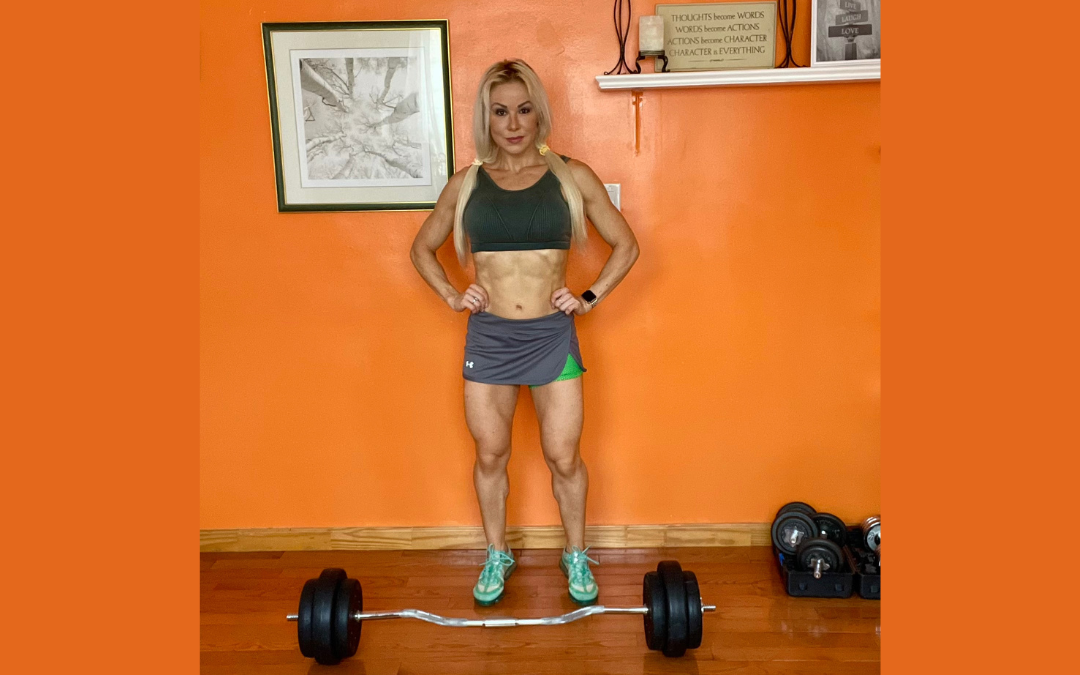Having well-developed shoulders gives you a great presence. A great exercise to sculpt and strengthen the shoulder muscles, mainly the rear delts, is the Barbell Face Pull. Below we’ll look into what muscles face pulls form, the benefits and mistakes associated with barbell face pulls, and how to properly do barbell face pulls form. Watch the barbell face pull video and check out other shoulder exercises to complete your shoulder workout.

The shoulder has several muscles that attach to the scapula, humerus, and clavicle. The largest shoulder muscle is the deltoid, which consists of the anterior, middle, and posterior fibers, giving the shoulder that nice rounded look. There are other muscles — the supraspinatus, infraspinatus, teres minor, and subscapularis — that form the rotator cuff and are vital in the dynamics of shoulder movement.
Other muscles involved in shoulder movement are the deltoid, supraspinatus, coracobrachialis, serratus anterior, pectoralis, trapezius, latissimus dorsi, teres major, and rhomboid major among others.
The shoulder area is one of the most mobile spheres in the body. The wide range of motion permits great rotation, abduction, and adduction. Simultaneously, this versatility makes the shoulder area more prone to injury.
What Muscles Do Barbell Face Pulls Work?
Barbell face pulls work the upper posterior chain muscles. The main muscle involved is:
- The rear deltoids: are located in the posterior part of the shoulders. This is a shoulder area that, sometimes, gets neglected. This is problematic since all the areas of the deltoid (anterior, lateral, and posterior or rear) need to be exercised in order to prevent injury and allow for shoulder mobility and stability
Other muscles involved in the movement are:
- Trapezius – triangular muscles extending over the back of the neck and shoulders
- Rhomboids – muscles located in the upper back in between the scapulas
Additionally, the lateral delts are engaged slightly.
Benefits of Face Pulls
The face pull is a very effective rear delt exercise and has many advantages:
- Shoulder Stability & Mobility: Face pulls work your upper posterior chain muscles which help keep your shoulder joint stable and mobile.
- Strength: They help increase overall shoulder strength as the rear delts can assist in other movements. Strong shoulders are important for everyday activities – movements involving pressing, pulling, and rotating your arms.
- Hypertrophy: Every muscle that you work grows with proper technique and nutrition. Face pulls help fill up the back of the shoulders.
- Aesthetics: They sculpt rounder, more defined shoulders, and traps, helping you develop a beautifully sculpted upper body.
- Isolation: This exercise is excellent to isolate the rear delts, muscles that are not often engaged. These muscles retract and engage during the face pull, which is also important for pressing movements.
- Posture: Working the rear delts helps avoid a “hunched forward” appearance and poor posture.
- Shoulder Health: They help deal with imbalances as most people concentrate on the anterior and lateral heads of the deltoids, not the rear deltoids. Working out every head of the deltoids helps to keep your shoulders healthy and prevent injuries.
- Versatility: Face pulls are versatile, easy to do, and can be performed without machines. Besides using a barbell to pull the weight straight toward your eye area, you can use cables, bands, or dumbbells.
Barbell Face Pulls Form
- Grab a barbell with your hands slightly wider than shoulder-width distance apart and with your palms facing down. Let the bar rest by your tights
- Stand with your feet about hip-width distance apart
- Bend your knees slightly and bend forward without rounding your back
- Keep your back straight and almost parallel to the floor, shoulders back, and core tight
- Lift the barbell up towards your face – mainly the eye area, keeping your elbows out
- Hold at the top of the movement for a couple of seconds, squeezing the back of your shoulders – You’ll feel your shoulder blades retract or pinch together
- Slowly lower the barbell down in a controlled way to the starting position
- Pause at the bottom for another second
- Repeat 12 to 15 times for 3 sets
*️⃣ This is not an exercise to perform with a very heavy weight as other muscles can easily assist and take the emphasis off the rear delts.
*️⃣ Besides performing the barbell face pull, you can do dumbbell face pulls which can be performed at home. You can also perform face pulls with cables/bands and stand instead of bending over.
Barbell Face Pulls Mistakes
- Improper form: The barbell face pull is an exercise in which you need to be very conscious of your posture and the muscles that you involve in order to perform it properly. If you move the weight towards your chin or neck, point your elbows down instead of out, or don’t keep your palms facing away from your face, you are performing face pulls incorrectly.
- Targeting other muscles: You should perform the face pulls form properly so you can feel the rear delts – the backside of your shoulders, not your lat or biceps.
- Lifting very heavy loads: The rear deltoid is a small area and if you put too much weight, you may end up using momentum and/or working other muscle groups to lift the load.
- Rounding your back: Keep your back straight so you don’t overstress or injure your back.
Barbell Face Pull Video
Shoulder Workout
If you want to target your rear delts further, you can also perform
In order to complete your delt workout, you should work your front and lateral deltoids. You can perform:
As you can see the barbell face pull is a wonderful shoulder exercise. It offers tremendous benefits associated with hypertrophy, strength, endurance, and aesthetics. Now that you know how to properly perform barbell face pulls, you can avoid the most common mistakes and enjoy their benefits. Remember, whether you want to lose weight, tone your body, or gain strength or size, all muscles must be trained.
Lift, Burn more Fat, Get Stronger, and Live Healthier!
To a Fitter Healthier You,
The Fitness Wellness Mentor



